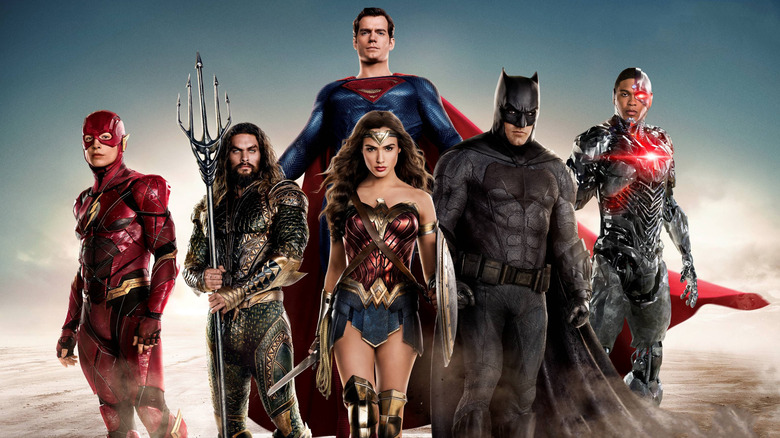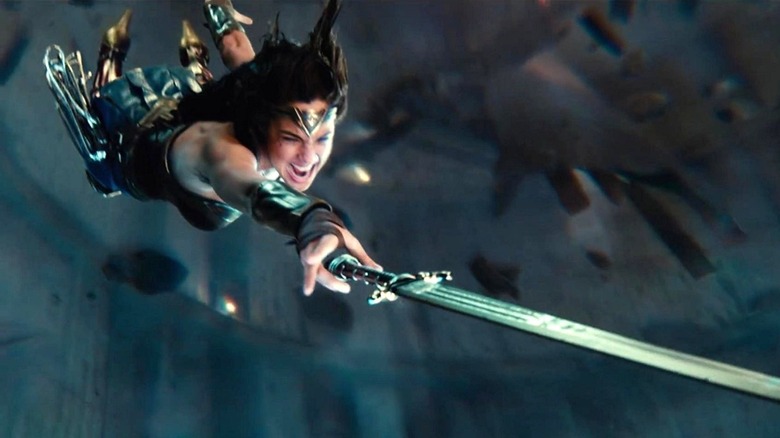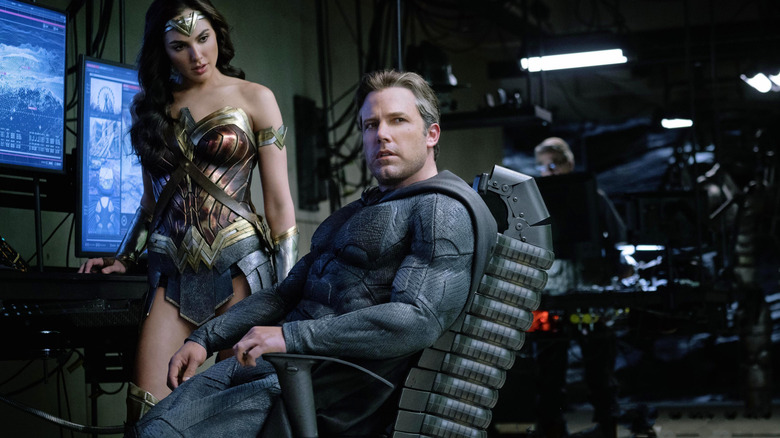The Most Expensive DC Movie Ever Made (And Why It Cost So Much To Make)
The storied production of Zack Snyder's "Justice League" has already become the stuff of filmmaking legend. Attempting to replicate the financial success and pop-cultural juggernaut of Marvel Studios' 2012 film "The Avengers," Warner Bros. attempted to build their own interconnected superhero film universe using the better-known, decades-older characters of Batman and Superman.
The Justice League first appeared in comic book form in 1960 (The Avengers, incidentally, didn't assemble until 1963), and a Justice League movie seemed like a logical way to compete with Disney's dominance. Additionally, Marvel Comics and DC Comics have long held a rivalry in the comic book marketplace, each controlling about the same share of sales for decades — not to mention each controlling their own true-blue fanbases — and it was logical to tap into the for-fun-rivalry that Marvel kids and DC kids already possessed.
(In an odd turn of events, when it came to adapting the respective company's superhero characters to the big screen, there appeared to be an ethos swap. DC had previously been known for depicting superheroes as bright-eyed gods and aspirational figures for whom struggle wasn't as notable as the inherent need to help others. Marvel, by contrast, featured ground-level human characters who still had to work dead-end jobs in between their superhero antics. In the feature films, characters like Superman and Batman became violent, struggling figures who made bad decisions and who were suspicious of one another. The Marvel characters were the ones who became upbeat, peppy, and weirdly godlike.)
Director Zack Snyder, who had previously made "Man of Steel" and "Batman v. Superman: Dawn of Justice," was to continue the series with "Justice League," the massive team-up movie to end all massive team-up movies. But due to a personal tragedy, Snyder was unable to finish the film, and Joss Whedon stepped in to complete the film, as well as offer a massively re-worked script. It underperformed. The rest is history. One can easily find the long road that eventually led to the longer cut of "Justice League."
In order to get the film they got, Warner Bros. spent $300 million.
$300 million
A budget of $300 million would make "Justice League" the fifth most expensive movie ever made behind "Avengers: Endgame," "Avengers: Age of Ultron," and "Avengers: Infinity War." The most expensive film ever made is "Pirates of the Caribbean: On Stranger Tides," which cost $379 million.
The reasons for the high cost are well-known. In order to shift tones and add scenes near the end of production, "Justice League" actors had to be re-hired for re-shoots, and entirely new sequences had to be completed in a hurry. Additionally, the film's color temperature needed to be adjusted to match the new lighthearted feeling the studio demanded. Henry Cavill, who plays Superman, had to be brought back from shooting "Mission: Impossible – Fallout," but, because of his contract on that film, was not allowed to shave his mustache, leading to a digital effect to cover it up. Every film goes through re-shoots, but the restructuring of "Justice League" was massive compared to the average blockbuster's post-production.
These new improvements would not have cost so much if Warner Bros. had allowed the time to make the improvements, and the scheduling leeway to shoot the scenes in a more careful fashion. But in Hollywood, the wisdom goes, you can only choose two of the following: Fast, good, and cheap. Warner Bros. was unwilling to delay "Justice League," and the studio worked under the gun to create the version they got, spending massive amounts of money to make sure it was completed on time. Whether or not the original version Snyder was working on would have been better — or would have been more successful — is a matter of speculation. The only reference point audiences have the is 2020 four-hour version of "Justice League" which required an additional $70 million to complete. It's hard to say how much that version resembles the version Snyder would have completed had he not experienced the tragedy in his family.
A parallel of the "Justice League" drama can be found in a famous example from the music video world. In 1995, director Mark Romanek was hired to make the music video for "Scream" by Michael and Janet Jackson. The production was ambitious, but Romanek was charged with conceptualizing the video and completing it in only one month, leading to 24-hour workdays, the hasty building of sets, and hiring huge teams to work on special effects. "Scream" and "Justice" were under the same gun.
Inflation
The inflating price tags on feature films is only partly due to inflation. Thanks to the labyrinthine economics of cinema production, costs of average feature films have steadily risen throughout history, coming to involve more and more people in the process, each of them requiring paychecks. What's more, filmmaking techniques have become more sophisticated over time, and the technology required to make films has advanced, leading to the need for more expensive equipment.
Thanks to blockbuster trends that started in the 1990s, studio tentpoles are expected to have giant price tags. We can blame James Cameron for that, as his 1994 film "True Lies" was the first film to cost more than $100m, and his 1997 film "Titanic" was the first to top $200m. After that, it became de rigueur to open the wallet for all the "big" ones.
Even adjusted for inflation, only two of the 20 most expensive films of all time were made before 2000: "Titanic" and "Waterworld" (which cost $322 million and $292 million, adjusted). Of the 100 most expensive films of all time, only two — "Cleopatra" in 1964 and "Superman" in 1978 — were made before 1995. Neither "Cleopatra" nor "Superman" cost as much as "Waterworld."
The first film to cost more than $1 million, just for trivia's sake, was the 1922 Erich von Stroheim film "Foolish Wives." It's available on Kanopy.
So the $300 million cost of "Justice League" is par for the course. Yes, that is a massive amount of money, but it is following the current trends of high-risk, high-return. Even on a disastrous production, the possibility of making $1 billion in several weeks would have made the price worth it. And since some of the most expensive films of all time are also the highest-earning, many studios see a calculated gamble in spending $300 million. A pity "Justice League" didn't make $1 billion.


